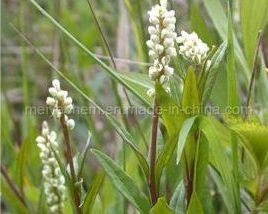Seneca Snakeroot
(Polygala senega)

Description
Polygala senega is a species of flowering plant in the milkwort family, Polygalaceae. It is native to North America, where it is distributed in southern Canada and the central and eastern United States. Its common names include Seneca snakeroot, senega snakeroot, senegaroot, rattlesnake root, and mountain flax. Its species name honors the Seneca people, a Native American group who used the plant to treat snakebite. This species is a perennial herb with multiple stems up to 50 centimeters tall. The stems are usually unbranched, but some old plants can have branching stems. A mature plant can have up to 70 stems growing from a hard, woody rootstock that spreads horizontally. The lance-shaped leaves are alternately arranged. The lower leaves are reduced and scale-like. The inflorescence is a spike of rounded white or greenish flowers. The fruit is a capsule containing two hairy black seeds. The root is twisted and conical, with a scent somewhat like wintergreen and a very pungent taste. There are two root Polymorphisms; a northern morph growing in Canada and toward Minnesota has larger roots up to 15 cm long by 1.2 cm wide which are dark brown and sometimes purplish toward the top, and a southern morph found in the southeastern United States that has smaller, yellow-brown roots. The plant grows on prairies and in woods and wet shoreline and riverbank habitat. It grows in thin, rocky, usually calcareous soils. It also occurs in disturbed habitat, such as roadsides. This plant had many uses among Native Americans. The Cherokee used it as an expectorant and a diuretic, and for inflammation, croup, and common cold. The Chippewa used preparations of the root to treat convulsions and bleeding wounds. The Cree chewed the root for sore throat and toothache. According to Canadian botanist Frère Marie-Victorin, the Seneca may have been inspired to use the root to treat snakebite by its resemblance to the tail of a rattlesnake. The root has economic value, so it is cultivated on a small scale, particularly in Japan, India, and Brazil. Until the 1960s, Canada was the largest exporter of the product, but there the root was collected from the wild. Most came from Saskatchewan and Manitoba. It is still wild-harvested today, and three quarters of the world's supply is taken from the wilds of the Interlake Region of Manitoba. Native peoples provide most of the labor, digging roots and selling them to drug companies.
Taxonomic tree:







